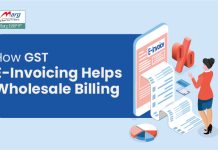Recent Updates on e-Invoicing:
10th May 2023
CBIC made an announcement on May 10, 2023, regarding the 6th phase of e-invoicing. As per the new guidelines, effective August 1, 2023, the threshold limit for GST e-invoicing has been lowered from ₹10 crores to ₹5 crores. This indicates that all registered individuals with an annual turnover of ₹5 crore or more are obligated to generate e-invoices for every tax invoice, debit note, and credit note issued to a registered person. The government’s objective behind implementing this measure is to boost GST taxpayer compliance and bring greater transparency to the GST system.
11 October 2022
According to the new regulations, starting on January 1, 2023, enterprises with a turnover of more than 5 crores may use the next stage of e-invoicing. Additionally, towards the end of the following fiscal year, it can be extended to businesses with revenues of at least 1core.
1st August 2022
As of October 1, 2022, businesses having an annual aggregate turnover of more than Rs. 10 crore and up to Rs. 20 crore shall use the e-Invoicing system for B2B transactions, per notice by CBIC.
4th July 2022
According to a government official, in order to lower the barrier from the existing Rs 20 crore, the government intends to make GST e-invoicing mandatory for businesses with a turnover of Rs 10 crore and higher from 1-10-2022.
24th February 2022
According to Notification No. 1/2022, the e-Invoicing system will be made available to businesses with an annual turnover of more than Rs. 20 crore and up to Rs. 50 crore as of April 1, 2022.
30th June 2021
The CBIC has issued a notification proposing to waive the penalty imposed for non-compliance with dynamic QR code regulations for B2C invoices between December 1, 2020, and September 30, 2021.
1st June 2021
A government department and local authority are exempt from the e-invoicing system, according to CBIC’s Central Tax Notification No. 23, dated June 1, 2021.
30th March 2021
The CBIC has published a notification to waive the fine for failing to follow the rules for dynamic QR codes for B2C invoicing between 1 December 2020 and 30 June 2021, provided that the person in question complies with the notification’s requirements starting on 1 July 2021.
Major Differences Between e-billing and e-invoicing
When you are in business, you have to understand the technical terms associated with it. Let’s talk about e-billing and e-invoicing here, which helps you move away from paper bills that need to be printed and mailed.
Introduction to e-billing
An electronic billing system is a simple way to post and pay bills electronically. This allows customers to get bills via email, web portal, or in machine-readable formats. Payments and deliveries are more efficient with e-billing.
Accounts Receivable handles e-billing through accounting software or ERP systems. Organizers and companies are switching to paperless processes to emphasize speed and accuracy, including follow-up actions if bill pay deadlines aren’t met.
Why is e-billing Software Beneficial?
- e-billing or electronic billing increases efficiency by taking less time to produce than paper bills. Paper bills require more effort and time to produce.
- High accuracy- Accounting software or ERP systems have direct access to electronic billing systems, thus eliminating human error from the entire process.
- Sending paper bills by mail increases the chance of errors or hindrances. The accuracy and flexibility of electronic billing are greater. As a result, both the company and the customer are able to work more efficiently.
The benefits of electronic billing or e-billing include status visibility, automation, streamlined bill payments, reduced overheads, scalability, and flexibility that are not available with paper bills.
Introduction to e-Invoicing
Electronic Invoicing or e-Invoicing refers to the exchange of invoice documents between suppliers and buyers. A paper-based invoicing process is harder and more prone to human error. With electronic invoicing, companies can get rid of the higher costs and processing lifestyles associated with paper-based invoicing.
For many years, e-invoicing has been used for B2B transactions using Electronic Data Interchange. As part of the electronic invoicing system, the GST Network’s Invoice Registration Portal (IRP) assigns identification numbers to each invoice.
Why e-invoicing is in focus today?
- With the help of e-invoicing Software, any organization can receive an invoice from different suppliers in any format.
- There is no copying or duplication of content between various devices and systems, and businesses can easily sync access and aggregate information.
- By increasing productivity and utilizing resources efficiently, e-invoicing allows an organization to save more money.
As companies digitize their processing cycles, e-invoicing has become one of their most strategic initiatives.
Free Download E-invoicing Software
Difference Between e-billing and e-invoicing
Invoicing and billing appear to be similar, but they have significant differences. A B2B bill is more likely to be electronic if it describes a specific aspect of the billing process. It is called e-billing when a customer receives a bill electronically from the business while receiving an invoice for specific deliverables against an order, which is termed receiving an invoice.
The invoice is a specific billing document that is made and sent during the billing process. Generally, e-billing encompasses a wider range of functions than EIPP or e-invoicing, such as invoice generation, delivery, follow-up, and payment handling. Furthermore, e-billing also includes a pricing table, and the ability to set a credit limit. As well as adjusting credit scores, it also closes the loop between payments and sales insight.
Conclusion
If you still have doubts about incorporating e-billing software into your business, then you should read out its benefits more loudly. To ensure the success of your e-billing deployment, it is equally important to select the right service provider. With Marg ERP, you can evaluate various aspects of the EIPP as well as a broader set of e-billing solutions.






